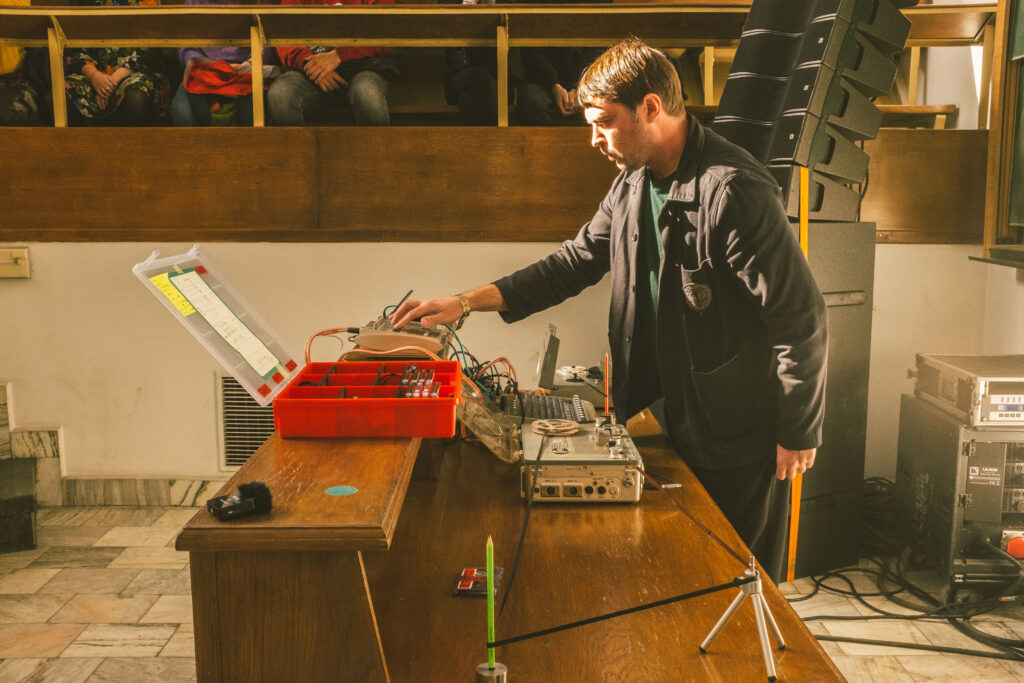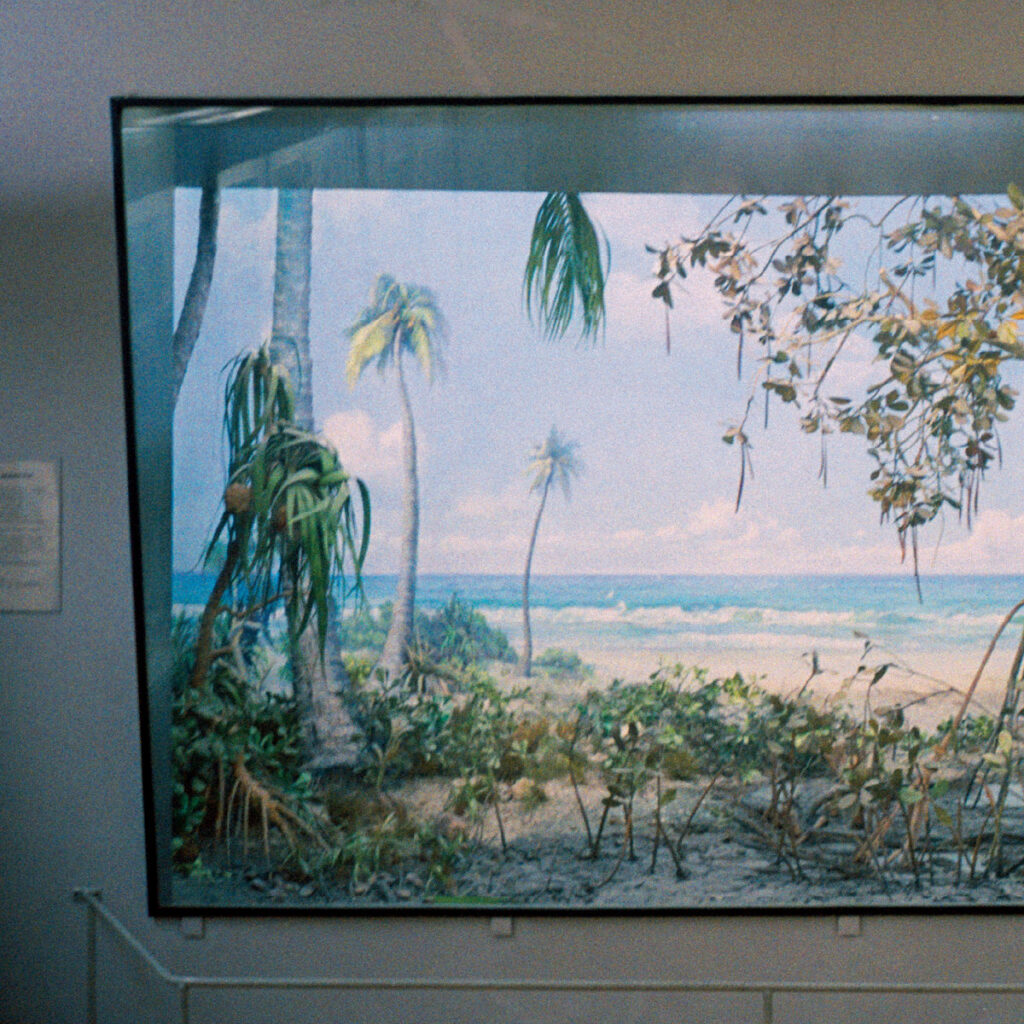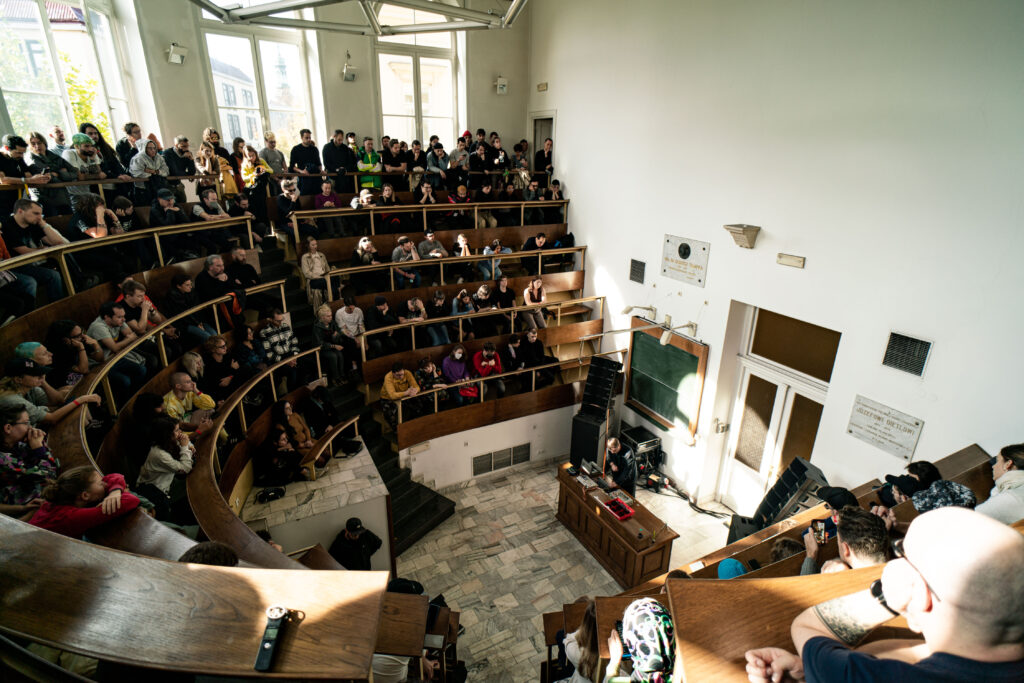
Nikolaienko is a Ukrainian sound artist. Dmytro works mainly with outdated music gear, which he uses to produce tape and cassette loops as base material for his sound collages, such as his album “Rings” (2021), released on Jan Jelinek’s Faitiche label. He has also released and appeared on such labels as 12th Isle, Graphical, Porridge Bullet, Kvitnu, Nexsound, Muscut and others. Dmytro Nikolaienko is also the founder of Muscut (est. 2012, Kyiv) – a label that focuses on modern avant-garde Eastern European artists, and a co-founder of Shukai – an archival label focused on bringing back to life the lost tapes of underrated artists who were persecuted by the censorship of the Soviet period.
How and where are you at the moment?
I never wanted to, but apparently I live a nomadic life. Currently, I’m in Amsterdam, The Netherlands. I moved here around three months ago from Tallinn, Estonia, where I lived for around four years. Originally I’m from Dnipro, but before moving to Tallinn, I lived in Kyiv, Ukraine for eight years.
You work with a lot of historical equipment – effects, reel-to-reels, tape players. What is it about this old equipment that attracts you?
Yes, it looks better and it smells better, but my approach and method are more pragmatic and environmentally conscious than nostalgic. Here is what I mean. I believe that every instrument remains an instrument, there is no expiration date. For me, a tape (reel or cassette) is an instrument, like a guitar – I don’t think you can say that a guitar is an outdated instrument. I reuse and recycle (and also service and maintain) “outdated” audio gear, equipment, and media, so I extend their life and try to expand their technical possibilities as instruments. I believe that there will always be new ideas to put into the old gear, making it impossible for that gear to become obsolete. I believe that the past doesn’t disappear or dissolve. All eras live simultaneously at the same time. Everyone has the freedom to choose which era they live in, they can surround themselves with the artefacts of their favourite era and isolate themselves in their bubble and not know what‘s happening in the mainstream (like I do, or like some of my friends who don’t have any social media do, for example). It’s not about being stuck in time – it’s about choosing your lifestyle and creating your own futurism.
Besides the technical aspects of making music with this media – there is also the aesthetic aspect – the sounds emanate wrapped in an echo, the ghosts in the machine; notions such as hauntology come to mind. But the sonics themselves are timeless, not referring to any particular era. They are rather liquid, almost subaquatic.
This question is so good, it describes my concept so precisely that I don’t have anything to add. Except that the notion of my music being timeless is rare (thanks again, I think I will use it in my press release, if I may). I often hear that my music belongs to the 60s-80s era, which I cannot agree with. There is a paradox in that it actually was technically possible for someone to make my music back in the 1960s-1980s or later (because I only use the gear that was available at that time). However, nobody did it back then (yes, artists were doing similar things, but not really that close) because there were other ideas, priorities, and requirements for the sound, e.g., musicians simply wanted to have sound that was clear rather than blurry and haunting, etc. If they (the musicians of that era) had digital files back then – only a few would have used tape – I know this, because I interviewed lots of artists from that era who we released on the archival label Shukai. Their eyes were sparkling when they talked about computers and how they wished they had had them when they were young, and how tape was a really shitty medium compared to a digital format and so on and so forth. But that’s not the case with me, I actually need tape to make music the way I want it to be/sound.

Your 2022 release, “Nostalgia Por Mesozóica”, is inspired by tropical synthscapes, alluding to recording techniques and sound properties of the 60s and 70s. A fictional electro/tropicalia world is built, a complex aural world of its own, which perhaps alludes to the past more than your other releases. Can you talk about this album and the notion of building your specific sonic universes?
First there was an image – a picture that I took in Kyiv’s Natural History Museum in 2013 (an artificial tropical landscape isolated behind a glass frame and fenced off by a handrail for more comfortable viewing), which haunted me afterwards, prompting me to do something with it. So it became the cover of the album before I did any of the sound. The title came later, around 2016. It was an irony about the mass culture obsession with nostalgia for the ’60s-90s, and my message was, why not the Mesozoic Era? It is very common for people to experience nostalgia for times they never lived in, so why not an era when no humans were yet alive? (wiki: The earliest humans did not evolve until around 2 million years ago. This means that the earliest cavemen were 63 million years too late to experience the last days of the Mesozoic Era).
Sound-wise, I had the idea of making artificial/synthesised field recordings (to accompany the cover image of the artificial tropical landscape), pseudo-ethnographic recordings of the exotic flora and fauna with easy listening and Fourth World music motives. There is no single sample of real field recording material. The album (started in 2016 and released in 2022) was fully created on studio synths – every sound is synthesised, from bird sounds to percussion beats. Then processed and deconstructed with tape loops to add more blurriness and a richer sound palette.

Working with these specific technologies is probably much harder in live situations – controlling the equipment in the way that you need to in the moment, live in front of an audience. How are your live performances?
Yes, every live show is very different when you work with this type of gear. I have a plastic toolbox where I store my tape loops; they are all labelled, but I still often confuse them so I also surprise myself when I mix loops that I haven’t mixed before – actually, that’s what I like the most in the live performances, it’s very close to studio work. When I work on the material and don’t surprise myself, that’s the worst. I only save (meaning I don’t erase the tape loops) if they really surprise me, and then I store them in my toolbox.
Another thing about the performances in general is that I think I should play my live shows in universities and museums rather than in concert spaces and clubs. I came to this conclusion after playing a live show at the Unsound festival in 2022, which was in an abandoned university lecture amphitheatre space. As I played, I realised that I belonged to that place more than any other place I had played in before. What I do during my live show is almost like a museum showcase or a lecture – a museum employee/university professor demonstrating historical media and gear – I only lack the white gloves when I perform… Later that year, I also played at the Royal Academy of Art in The Hague in front of audio faculty students with a similar feeling, which confirmed my thoughts.
Besides being a musician, you also run two labels: Muscut, which has released several noteworthy releases by Ukrainian and other artists. According to its Bandcamp page, the label is “focusing on pseudo and practical audio archaeology.” Can you talk about Muscut?
Another label you run is Shukai, which focuses on archival releases, soundtracks etc. What importance does sonic archaeology have for you?
The two labels are different but try to be similar – one trying to release timeless music by contemporary artists, the other looking for timeless music lost in the archives. Philip Sherburne wrote recently in his review of one of the label’s releases: “Muscut releases mostly new music, while its sublabel Shukai tends to concentrate on archival releases, but without looking at the logo stamped on the sleeve, you’d often be hard pressed to know which category a given release belongs to” – I found this formulation so good and accurate that I even put it into a press release, replacing the old description of “pseudo and real archaeology.”
Apart from that, my intention in establishing the first (Muscut, est. 2012) label was to create a niche label with artists, primarily from Eastern Europe, who make similar music. So similar that you could be forgiven for thinking that it’s a single artist making music under different aliases. Coincidentally, it’s the 12th anniversary of the Muscut label this month.
And lastly, what are your current projects, both in terms of your solo work and your labels?
There are many plans; two solo albums will be released this year and next year, which is not typical for me as I usually have a three- or four-year break between such releases. This year’s album is called META and will be released on cassette this autumn on Muscut. It’s an album where I’ve limited myself to using only two instruments – a metallophone and a four-track tape recorder. Explorations of the metallophone and tape sounds, deconstructed and reintegrated into tracks with cassette loops. This release is part of this year’s lseries, which is dedicated not to electronic but to electro-acoustic music with a focus on analogue recording and production. Like the record released just last week – Hennadii Boichenko’s 7″ Sea Songs, for which I did the mixing and tape mastering. It was the first time in the label’s history that we sent reel tape as a master to the vinyl pressing plant instead of the digital files we used to use.
As for the archival releases on Shukai, we have lost contact with many artists due to the Russian invasion. There were projects in progress, which are on hold at the moment. The artists are older people without email, for example, and we had been talking with them via mobile phone, but they are no longer responding. We think they might have left the country with their families and their phones are simply out of roaming.
Interview by Lucia Udvardyova
Photo by Jakub Knera (at Unsound), Malinski